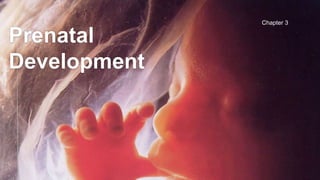Manis 2017 ch 3 pt 1 no vid
- 4. Fertilization Fertilization—process that occurs in the fallopian tubes when the sperm and ova combine to form a zygote Zygote—a single cell organism that results from the fertilization of an egg cell by a sperm; the fertilized egg Gametes – sexual reproduction cells Ova—female reproductive cell Sperm—male reproductive cell
- 6. The Germinal Period: 0 – 2 Weeks Blastocyst—the term given to the zygote at about day 5 or 6 postfertilization
- 7. o Includes the separation of the three germ layers of somatic cells o Ends with the implantation of the gastrula into the uterine wall Germinal period begins with the fertilization of the egg
- 8. Ectoderm – nervous system (including the brain and spine), skin, nails, and hair, as well as the salivary, pituitary, and mammary glands Endoderm –thyroid gland, bladder, lungs, and digestive system Mesoderm –heart, circulatory and lymph systems, connective tissue, muscle, and bones
- 9. The Period of the Embryo: 3 to 8 Weeks Embryonic period –beginning of week 3 and continuing through week 8; organogenesis takes place Organogenesis – development of major organ systems during the embryonic period; by the end of week 8, 95% of major organs are complete
- 11. Third week: The neural plate forms and becomes the brain and neural tube (spinal cord). Neurogenesis, the production of neurons begins. The heart chambers and blood vessels develop. Eighth week: The embryo appears more human, the inner and middle ear develop, and the embryo is the size of a grape.
- 13. Copyright © 2017 Pearson, Inc. All Rights Reserved Periods of Prenatal Development The Embryo and Its Supporting Structures
- 14. The Amnion • The amnion is one of the life support systems that develops from the trophoblast • Develops from the fertilized egg not from the mothers body
- 15. Copyright © 2017 Pearson, Inc. All Rights Reserved Periods of Prenatal Development Formation of the Neural Tube and Neural Tube Defects
- 16. The Period of the Fetus: 9 Weeks to Birth The period of prenatal development that begins after organogenesis is 95% complete at about week 9 and continues until birth.
- 17. Fetal Development By 24 weeks: Fat begins to accumulate. Bone marrow begins producing red blood cells. Eyes are fully formed. The fetus is 9 inches long and weighs 21.6 oz. Viability – The ability of the fetus to survive outside the womb; at about week 24 to 25. By 40 weeks: The fetus gains 50% of its birth weight in the last month. The skin is smooth. The head has hair. Myelination increases. The fetus is the size of the average newborn: roughly 17 – 20 inches long and weighing about 7 lbs.
- 18. Copyright © 2017 Pearson, Inc. All Rights Reserved Periods of Prenatal Development Brain Growth in the Prenatal Period
Editor's Notes
- Key question 2: What happens in the womb before birth?
- LO 3.1: Describe the major events of the germinal period.
- LO 3.2: Describe the major events of the embryonic period. Figure 3.3: Formation of the Neural Tube and Neural Tube Defects Row A shows the steps in neural tube formation and closure. Picture B shows points in development when the tube either closes (top) or fails to close (bottom). Picture C shows the regions where neural tube defects occur in an embryo at 4 weeks of age.
- LO 3.4 Describe the four main processes of brain development in the prenatal period.



















